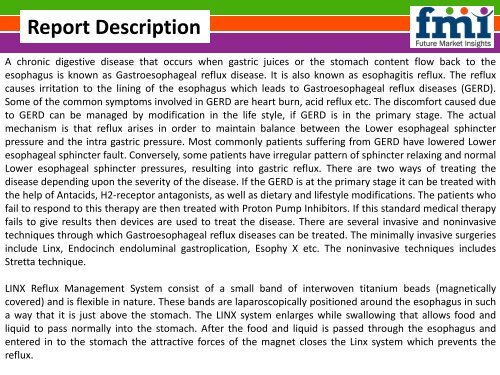Gastroesophageal Reflux Diseases Devices Market size in terms of volume and value 2016-2026
A chronic digestive disease that occurs when gastric juices or the stomach content flow back to the esophagus is known as Gastroesophageal reflux disease. It is also known as esophagitis reflux. The reflux causes irritation to the lining of the esophagus which leads to Gastroesophageal reflux diseases (GERD). Some of the common symptoms involved in GERD are heart burn, acid reflux etc. The discomfort caused due to GERD can be managed by modification in the life style, if GERD is in the primary stage. The actual mechanism is that reflux arises in order to maintain balance between the Lower esophageal sphincter pressure and the intra gastric pressure. Most commonly patients suffering from GERD have lowered Lower esophageal sphincter fault. Conversely, some patients have irregular pattern of sphincter relaxing and normal Lower esophageal sphincter pressures, resulting into gastric reflux. There are two ways of treating the disease depending upon the severity of the disease. If the GERD is at the primary stage it can be treated with the help of Antacids, H2-receptor antagonists, as well as dietary and lifestyle modifications. The patients who fail to respond to this therapy are then treated with Proton Pump Inhibitors. If this standard medical therapy fails to give results then devices are used to treat the disease. There are several invasive and noninvasive techniques through which Gastroesophageal reflux diseases can be treated. The minimally invasive surgeries include Linx, Endocinch endoluminal gastroplication, Esophy X etc. The noninvasive techniques includes Stretta technique.
A chronic digestive disease that occurs when gastric juices or the stomach content flow back to the esophagus is known as Gastroesophageal reflux disease. It is also known as esophagitis reflux. The reflux causes irritation to the lining of the esophagus which leads to Gastroesophageal reflux diseases (GERD). Some of the common symptoms involved in GERD are heart burn, acid reflux etc. The discomfort caused due to GERD can be managed by modification in the life style, if GERD is in the primary stage. The actual mechanism is that reflux arises in order to maintain balance between the Lower esophageal sphincter pressure and the intra gastric pressure. Most commonly patients suffering from GERD have lowered Lower esophageal sphincter fault. Conversely, some patients have irregular pattern of sphincter relaxing and normal Lower esophageal sphincter pressures, resulting into gastric reflux. There are two ways of treating the disease depending upon the severity of the disease. If the GERD is at the primary stage it can be treated with the help of Antacids, H2-receptor antagonists, as well as dietary and lifestyle modifications. The patients who fail to respond to this therapy are then treated with Proton Pump Inhibitors. If this standard medical therapy fails to give results then devices are used to treat the disease. There are several invasive and noninvasive techniques through which Gastroesophageal reflux diseases can be treated. The minimally invasive surgeries include Linx, Endocinch endoluminal gastroplication, Esophy X etc. The noninvasive techniques includes Stretta technique.
You also want an ePaper? Increase the reach of your titles
YUMPU automatically turns print PDFs into web optimized ePapers that Google loves.
Report Description<br />
A chronic digestive disease that occurs when gastric juices or the stomach content flow back to the<br />
esophagus is known as <strong>Gastroesophageal</strong> reflux disease. It is also known as esophagitis reflux. The reflux<br />
causes irritation to the l<strong>in</strong><strong>in</strong>g <strong>of</strong> the esophagus which leads to <strong>Gastroesophageal</strong> reflux diseases (GERD).<br />
Some <strong>of</strong> the common symptoms <strong>in</strong>volved <strong>in</strong> GERD are heart burn, acid reflux etc. The discomfort caused due<br />
to GERD can be managed by modification <strong>in</strong> the life style, if GERD is <strong>in</strong> the primary stage. The actual<br />
mechanism is that reflux arises <strong>in</strong> order to ma<strong>in</strong>ta<strong>in</strong> balance between the Lower esophageal sph<strong>in</strong>cter<br />
pressure <strong>and</strong> the <strong>in</strong>tra gastric pressure. Most commonly patients suffer<strong>in</strong>g from GERD have lowered Lower<br />
esophageal sph<strong>in</strong>cter fault. Conversely, some patients have irregular pattern <strong>of</strong> sph<strong>in</strong>cter relax<strong>in</strong>g <strong>and</strong> normal<br />
Lower esophageal sph<strong>in</strong>cter pressures, result<strong>in</strong>g <strong>in</strong>to gastric reflux. There are two ways <strong>of</strong> treat<strong>in</strong>g the<br />
disease depend<strong>in</strong>g upon the severity <strong>of</strong> the disease. If the GERD is at the primary stage it can be treated with<br />
the help <strong>of</strong> Antacids, H2-receptor antagonists, as well as dietary <strong>and</strong> lifestyle modifications. The patients who<br />
fail to respond to this therapy are then treated with Proton Pump Inhibitors. If this st<strong>and</strong>ard medical therapy<br />
fails to give results then devices are used to treat the disease. There are several <strong>in</strong>vasive <strong>and</strong> non<strong>in</strong>vasive<br />
techniques through which <strong>Gastroesophageal</strong> reflux diseases can be treated. The m<strong>in</strong>imally <strong>in</strong>vasive surgeries<br />
<strong>in</strong>clude L<strong>in</strong>x, Endoc<strong>in</strong>ch endolum<strong>in</strong>al gastroplication, Esophy X etc. The non<strong>in</strong>vasive techniques <strong>in</strong>cludes<br />
Stretta technique.<br />
LINX <strong>Reflux</strong> Management System consist <strong>of</strong> a small b<strong>and</strong> <strong>of</strong> <strong>in</strong>terwoven titanium beads (magnetically<br />
covered) <strong>and</strong> is flexible <strong>in</strong> nature. These b<strong>and</strong>s are laparoscopically positioned around the esophagus <strong>in</strong> such<br />
a way that it is just above the stomach. The LINX system enlarges while swallow<strong>in</strong>g that allows food <strong>and</strong><br />
liquid to pass normally <strong>in</strong>to the stomach. After the food <strong>and</strong> liquid is passed through the esophagus <strong>and</strong><br />
entered <strong>in</strong> to the stomach the attractive forces <strong>of</strong> the magnet closes the L<strong>in</strong>x system which prevents the<br />
reflux.

















